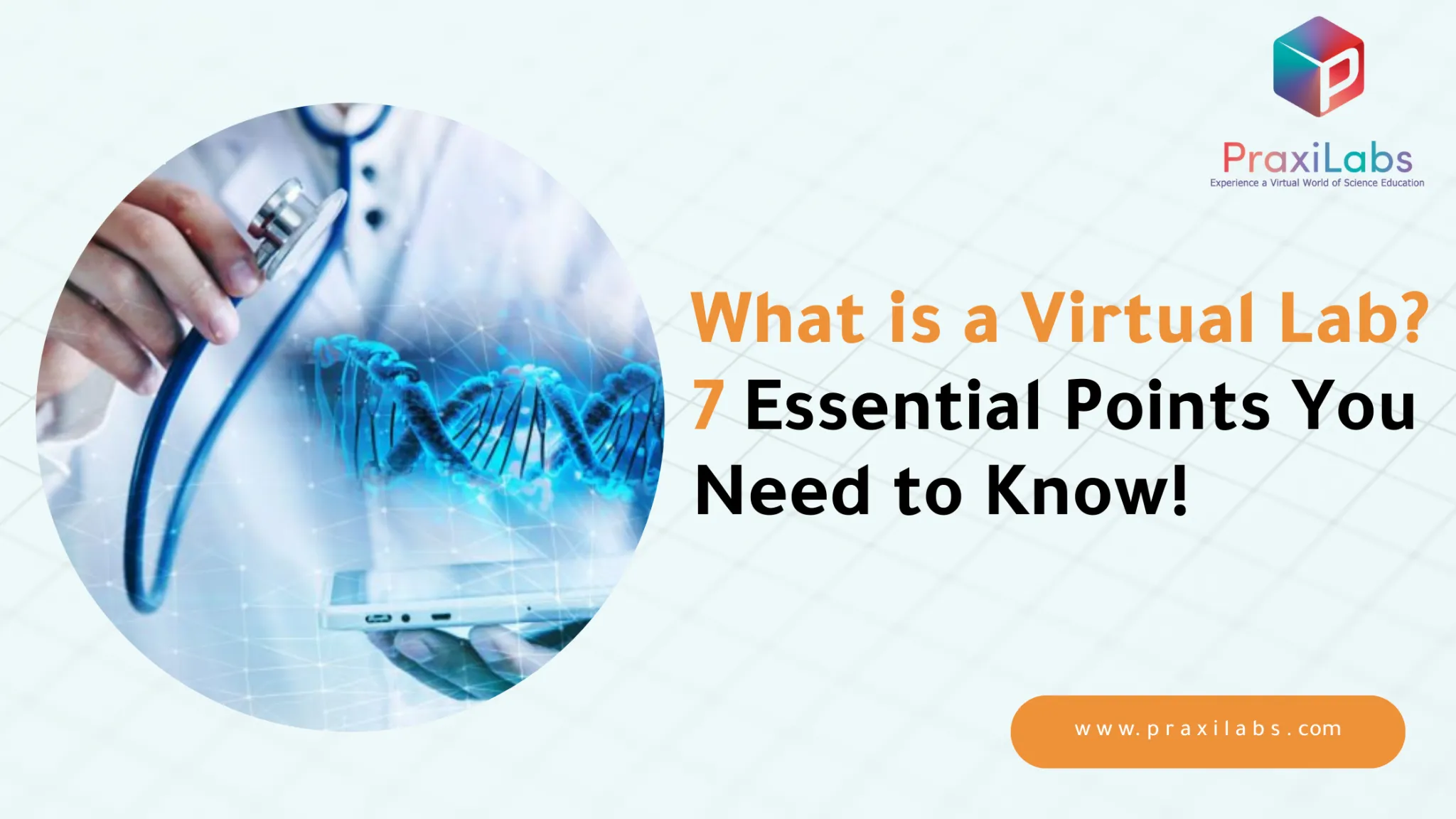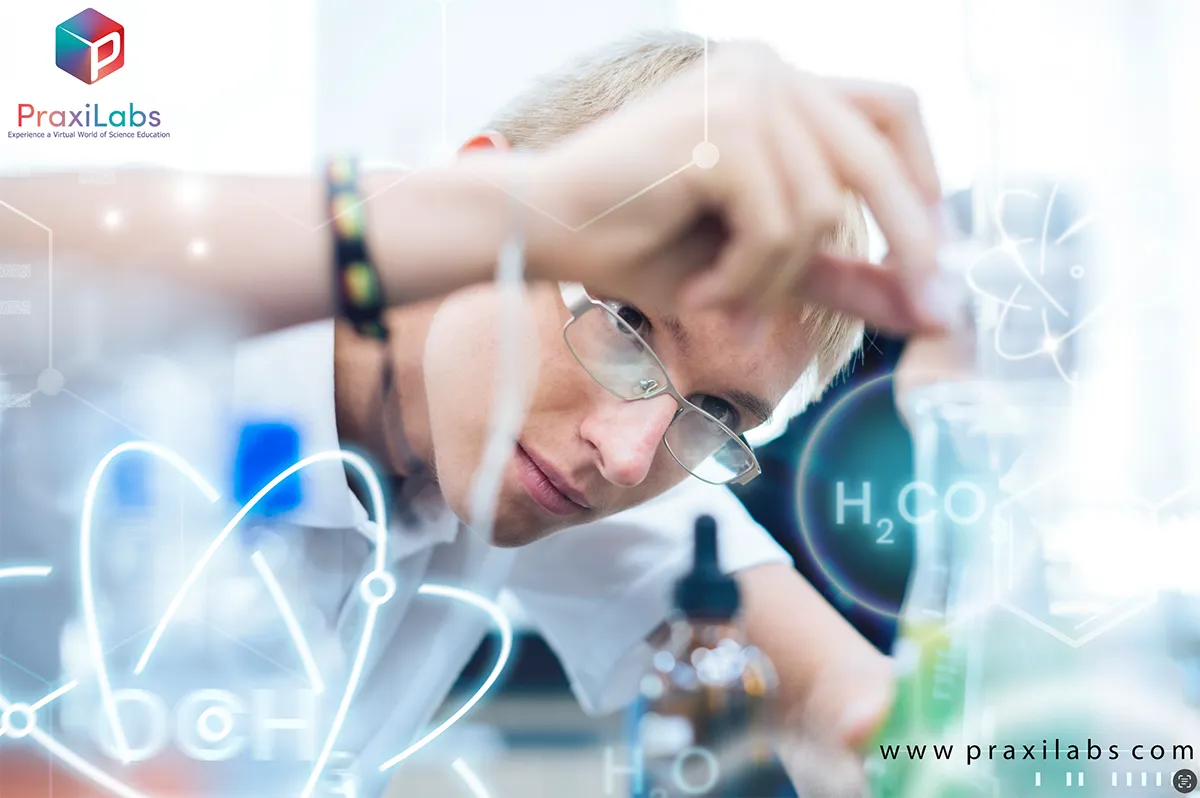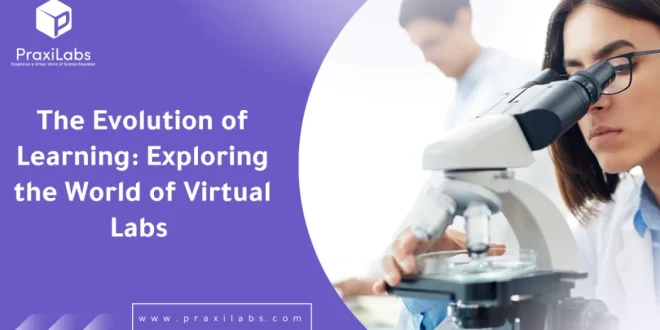Last Updated on October 26, 2025 by Muhamed Elmesery
Virtual lab simulation is now one of the most important and widely spread e-learning techniques. It is an immersive 3D simulation in science that enables students to conduct science experiments online, from their personal devices anytime , anywhere.
These labs allow students to explore and interact with various scientific concepts, conduct experiments, collect data, calculate the final results, and analyze them, all within a virtual environment.
In this blog post, we will delve into the world of virtual laboratories and explore their benefits, objectives, components, examples of virtual simulations from PraxiLabs in the field of chemistry, physics, and biology, and more!

Table of Contents
What is a Virtual Lab? 7 Essential Points You Need to Know
- A virtual lab is an interactive and immersive environment for creating and conducting simulated experiments that typically take place in physical laboratory settings.
- It use computers to provide highly interactive virtual reality simulations of laboratory exercises. It provides students with access to realistic science experiments, from their personal devices anytime and at their own pace, anywhere, without any pressure.
- It can be accessed anywhere, anytime, both online or offline.
- A virtual lab is one where the student interacts with an experiment that is either remote from the student or which has no immediate physical reality.
- Virtual labs allow for a unique opportunity of learning through making mistakes with no potential safety hazards for the students nor any additional costs due to waste of materials and consumables.
- Virtual simulations address the limitations of traditional science labs such as safety hazards, high costs, ethical challenges e.g. animal testing, limited access for students, lack of engagement and student interest, and high student dropout rates.
- Virtual Laboratories Improve students outcomes:
- 60% improvement in student performance.
- 80% increase in student retention.
Increase your Students’ Learning Retention and Engagement With PraxiLabs’ simulations!
How to access a virtual lab?
To access a virtual lab on your Laptop or Desktop Computer, you will need the following:
- Laptop/Computer.
- Operating system.
- Internet access.
- Modern web browser.
Once you create your free account on one of platforms that provide users with virtual simulations, you can interact and perform experiments easily.
What are the components of Virtual Laboratory?
Virtual laboratory must be supported by the following main requirements:
- Remote operation: in order to have access and manipulate tools and equipment located at a remote workshop
- Information management: to store information and data generated by the experiments conducted.
- Simulation: to visualize and reproduce the actions at the remote facility.
- Collaborative tools: in order to share and coordinate the experiments among different partners worldwide.

What are the objectives of virtual labs?
- Virtual labs motivate students to conduct laboratory experiments.
- They satisfy the scientific curiosity of students, allowing them to access the various experiments easily regardless of time or place.
- Increase understanding of scientific courses in physics, chemistry and biology, and improve student achievement.
- Eliminate boredom as it provides fun during the experiments.
- They increase scientific research opportunities as they save time and effort and enable researchers to use their time more effectively.
- Enabling students to use modern technology and keep pace with the rapid advancement of the information revolution.
- Students will be able to use the scientific method for problem-solving.
- Develop teaching and learning methods that will lead to the effectiveness of the educational process.
- Increased communication between students and each other on the Internet, which helps with the exchange of ideas and experiences.
What’s included in virtual labs?
They typically include a variety of 3D science experiments that students can interact with and conduct easily. Some platforms also offer extra lab resources such as lab manuals, tutorials, multiple-choice questions (MCQs), enriching information files, and more. Additionally, users can collect data from different runs, analyze them, fill in appropriate tables and sheets, and observe how nature works.
Are virtual labs effective?
Yes, studies have shown that virtual simulations can be as effective as physical laboratory activities in teaching certain subjects. Furthermore, integrating lab simulations into teaching strategies has been observed to yield high student engagement and positive feedback.
Virtual Labs Improve student outcomes:
- 60% of students’ performance.
- 80% of students’ retention.
Is Virtual Labs free?
Yes, several platforms provide their users with free virtual labs to increase their understanding and enhance their learning outcomes.
For example, the free plan from PraxiLabs offers 3 free simulations with all the features you need such as unlimited repetitions, instant guidance, complementary content, Arabic & English interface, and all updates. However, with paid plans, you can go through all the simulations portfolio available and select what you need.
Get your free online access for immersive virtual labs now!

Elevate Your Science Skills: Discover the Interactive World of PraxiLabs!
PraxiLabs provides students with an immersive and interactive 3D simulation of a realistic lab, enhancing their understanding and knowledge with a virtual hands-on experience of what they’ve learned.
PraxiLabs enriches the experimentation process through visual aids that guide the students through the process. Students no longer get stuck, but rather enjoy the help of a virtual partner, when needed, which also provides guidance to prevent wrong choices. Moreover, students are quickly tested on the basic results of their experiment to ensure an enhanced learning experience.
PraxiLabs offers a wide variety of virtual labs from different science branches, providing a broad spectrum of learning opportunities.
We provide virtual physics science experiments in:
Properties of matter virtual labs
- Archimedes Principle
- Young’s Modulus for a Metallic Rod Simulation
- Determination of Coefficient of Viscosity by Stokes Method
- Density Measurement
Waves virtual labs
- Focal Length of a Convex Lens Using General Law
- Simple Pendulum
- Hooke’s law simulation
- Speed of Sound Using Open Columns
- Speed of Sound Using Closed Columns
Modern physics virtual labs
- Black Body Radiation
- Laser Beam Divergence
- Laser Electro-Optic Effect
- Millikan Oil Drop
- Michelson’ Interferometer
- I-V Characteristics of Solar Cell (I)
- I-V Characteristics of Solar Cell (lI)
- I-V Characteristics of Solar Cell (llI)
- Zeeman Effect Simulation
Heat and thermodynamics virtual labs
- Specific Heat of Solids
- Boyle’s Law of Gases
- Joule’s Experiment
Mechanics virtual labs
- Free Fall Simulation
- Motion on Inclined Surface
- Ballistic Pendulum
- Newton’s Second Law
Magnetism virtual labs
- Magnetic Moment of a Bar Magnet
- Magnetic Field of a Circular Loop Current
Electricity virtual labs
- Measurement of Ohmic Resistances Using Ammeter and Voltmeter
- Study the I-V Characteristics of Non-Ohmic Resistance Simulation
- Kirchhoff’s Loop Rule
- RC Circuit (Charging Capacitor)
- RC Circuit (Discharging Capacitor)
- Variation of the Resistance of a Thermistor with Temperature
Also, PraxiLabs provides a wide range of advanced experiments in chemistry:
Analytical Chemistry Experiments
- Determination of Sulphuric Acid Concentration by Titration
- Determination of Concentration of Acetic Acid Solution in its Commercial Vinegar Titration
- Analysis Mixture of Sodium Hydroxide and Sodium Carbonate by Warder Titration
- Standardization of Potassium Permanganate
- Weak base / Strong acid titration
- Determination of Concentration of Citric Acid in Soda by Titration
- (Strong acid / strong base titration) HCl/NaOH
- Determination of Concentration of Silver Nitrate by Fajanʼs Method
- Determination of Water Hardness by Complexometric Titration
- Determination of Concentration of Chlorides in Water Sample (Volhard’s Method)
- Standardization of Sodium Thiosulphate using Iodimetric Titration
- GC/MS Analysis
- Determination of Concentration of Silver Nitrate by Mohrʼs Method
- NMR Analysis
Organic Chemistry Experiments from PraxiLabs
PraxiLabs provides a group of organic chemistry practical experiments:
- Esterification
- Diels Alder Reaction
- Synthesis of Aspirin
- Reaction of Alkyl Halides (Hydrolysis of Alcohols)
- Electrophilic Substitution (Azo Coupling)
- Friedel Crafts Acylation of Anisole
Inorganic Chemistry Experiments from PraxiLabs
PraxiLabs also provides inorganic chemistry practical experiments like:
- Test for Sulphite Radical
- Test for Carbonate Radical
- Test for Bicarbonate Radical
- Test for Iodide Radical
- Test for Bromide Radical
- Test for Sulphide Radical
- Test for Thiosulphate Radical
- Test for Chloride Radical
- Test for Silver Radical

PraxiLabs provides a wide range of experiments in biology in disciplines:
- Molecular Biology
- Genetics
- Microbiology
- Immunology
- Toxicology
- Bioenergetics
- Biochemistry
- Cell Culture
- Microscopy
- Proteomics
- Pharmacology
Visit Our Ever-Expanding Catalog of 3D Chemistry lab Simulations and Enhance Your Students’ Learning Outcomes!
 PraxiLabs A virtual world of science
PraxiLabs A virtual world of science






